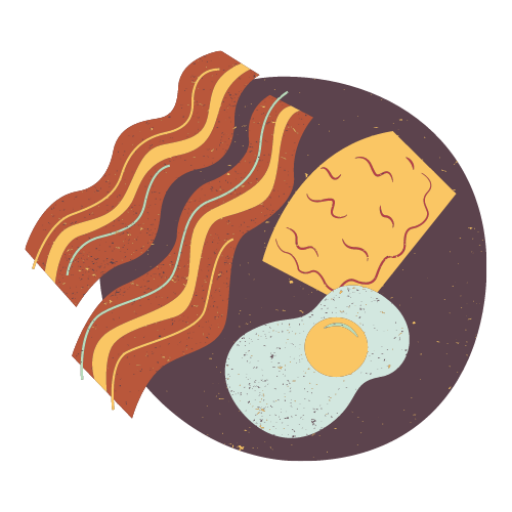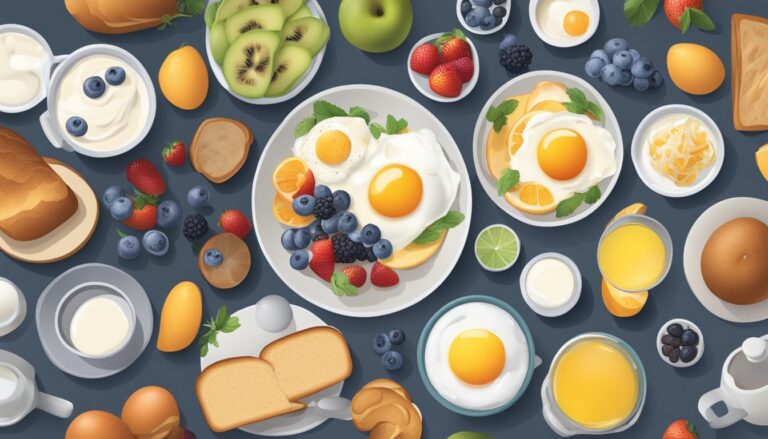Starting your day with a nutritious, low-cholesterol breakfast can set the tone for better heart health. Many delicious recipes naturally support lower cholesterol levels without sacrificing flavor or satisfaction. These 15 breakfast recipes are packed with fiber, lean proteins, and heart-healthy fats to help manage cholesterol while providing a tasty start to your morning.
From smoothie bowls bursting with berries to savory egg white wraps filled with colorful vegetables, these options cater to various tastes and dietary preferences. Whole grains like oatmeal feature prominently, offering a hefty dose of cholesterol-lowering beta-glucan fiber. Plant-based ingredients take center stage, with soy milk, nuts, and seeds providing essential nutrients and helping to reduce intake of saturated fats.
Incorporating these recipes into your routine can be an enjoyable way to support heart health. By choosing wholesome ingredients and preparing meals at home, you have greater control over what goes into your body. These breakfast ideas prove that eating for lower cholesterol doesn’t mean bland or restrictive meals.
Understanding Cholesterol and Heart Health

Cholesterol plays a crucial role in bodily functions, but its impact on heart health depends on the type and amount present. Dietary choices significantly influence cholesterol levels and cardiovascular risk.
The Role of Cholesterol in the Body
Cholesterol is essential for cell membrane structure and hormone production. It aids in vitamin D synthesis and helps digest fats. The liver produces most of the body’s cholesterol, with a smaller portion coming from food.
Despite its importance, excess cholesterol can lead to health issues. It can accumulate in artery walls, forming plaques that narrow blood vessels. This process, known as atherosclerosis, increases the risk of heart disease and stroke.
Maintaining optimal cholesterol levels through diet and lifestyle is key to cardiovascular health.
Differences Between LDL and HDL
LDL (Low-Density Lipoprotein) and HDL (High-Density Lipoprotein) are two main types of cholesterol carriers in the blood.
LDL Cholesterol:
- Often called “bad” cholesterol
- Transports cholesterol to body tissues
- Can build up in artery walls
- High levels increase heart disease risk
HDL Cholesterol:
- Known as “good” cholesterol
- Removes excess cholesterol from tissues
- Carries cholesterol back to the liver for disposal
- Higher levels associated with reduced heart disease risk
Maintaining a balance between LDL and HDL is crucial for heart health. Ideal levels vary based on individual health factors and risk profiles.
Impact of Diet on Heart Disease and Stroke
Diet significantly influences cholesterol levels and cardiovascular health. Consuming foods high in saturated and trans fats can raise LDL cholesterol, increasing heart disease and stroke risk.
A heart-healthy diet includes:
- Fruits and vegetables
- Whole grains
- Lean proteins
- Healthy fats (e.g., olive oil, avocados)
Limiting intake of processed foods, red meat, and high-fat dairy products can help lower LDL cholesterol. Regular consumption of soluble fiber, found in oats and beans, can reduce cholesterol absorption.
Incorporating these dietary changes, along with regular exercise and maintaining a healthy weight, can significantly reduce the risk of heart disease and stroke.
Essential Ingredients for Low-Cholesterol Breakfasts

Creating heart-healthy breakfasts starts with choosing the right ingredients. Key components include whole grains, fruits, nuts, and fiber-rich foods that can help manage cholesterol levels naturally.
Oats and Whole Grains
Oatmeal is a powerhouse for lowering cholesterol. Rolled oats contain beta-glucan, a type of soluble fiber that helps reduce LDL cholesterol. A daily serving of 1.5 cups of cooked oatmeal can lower cholesterol by 5-8%.
Quinoa offers a protein-packed alternative to oats. It’s gluten-free and rich in fiber, making it an excellent choice for those watching their cholesterol.
Whole grain breads and cereals provide additional fiber and nutrients. Look for products with “100% whole grain” on the label to ensure you’re getting the full benefits.
Fruits and Berries
Berries are antioxidant-rich and low in calories. Strawberries, blueberries, and raspberries can be added to oatmeal, smoothies, or eaten on their own.
Apples contain pectin, a type of soluble fiber that helps lower cholesterol. Eating an apple a day may indeed keep the doctor away.
Citrus fruits like oranges and grapefruits are high in vitamin C and fiber. They can help boost your immune system while supporting heart health.
Nuts, Seeds, and Healthy Fats
Almonds, walnuts, and chia seeds are rich in omega-3 fatty acids and fiber. A small handful can add crunch and nutrition to your breakfast.
Ground flaxseed is an excellent source of lignans and omega-3s. Sprinkle it on yogurt or blend it into smoothies for an easy nutrient boost.
Avocado provides healthy monounsaturated fats. Spread it on whole grain toast or add it to smoothies for a creamy texture.
High-Fiber Foods
Psyllium husk is a concentrated source of soluble fiber. It can be mixed into smoothies or oatmeal to increase fiber intake.
Beans and lentils are fiber-rich and versatile. Try adding them to breakfast burritos or savory morning bowls.
Vegetables like spinach and kale can be incorporated into omelets or smoothies. They’re low in calories and high in fiber and nutrients.
Top Breakfast Recipes to Lower Cholesterol
Incorporating heart-healthy ingredients into your morning meal can help manage cholesterol levels. These recipes focus on fiber-rich whole grains, lean proteins, and nutrient-dense fruits and vegetables to support cardiovascular health.
Oat-Based Breakfasts
Overnight oats offer a convenient and customizable low-cholesterol breakfast option. Combine rolled oats with chia seeds, almond milk, and a touch of honey. Let the mixture chill overnight for a creamy texture.
Baked oatmeal provides a warm, comforting start to the day. Mix oats with mashed banana, cinnamon, and chopped nuts. Bake until golden for a filling breakfast that can be prepared in advance.
For a savory twist, try a quinoa breakfast bowl. Cook quinoa in vegetable broth, then top with sautéed spinach, cherry tomatoes, and a sprinkle of nutritional yeast for a protein-packed meal.
Smoothie and Smoothie Bowl Variations
Fruit smoothies blend nutrition and convenience. Combine frozen berries, banana, spinach, and low-fat milk for a quick, antioxidant-rich breakfast. Add ground flaxseed for extra fiber and omega-3 fatty acids.
Smoothie bowls elevate the traditional smoothie. Create a thick base with frozen açai, mixed berries, and Greek yogurt. Top with sliced almonds, chia seeds, and fresh fruit for added texture and nutrients.
For an anti-inflammatory boost, try a turmeric and ginger smoothie. Blend frozen mango, banana, turmeric, ginger, and coconut water. This golden drink may help reduce inflammation and support heart health.
Egg White Delights
Egg white frittatas offer a protein-rich, low-cholesterol breakfast. Whisk egg whites with diced vegetables like bell peppers, onions, and spinach. Cook in a non-stick skillet and finish under the broiler for a fluffy texture.
Egg white breakfast wraps provide a portable option. Fill a whole-grain tortilla with scrambled egg whites, black beans, salsa, and avocado slices. Roll up for a satisfying meal on the go.
For a twist on classic eggs Benedict, try an egg white florentine. Top whole-grain English muffins with sautéed spinach, poached egg whites, and a light yogurt-based hollandaise sauce.
Tofu-Infused Dishes
Tofu scrambles offer a plant-based alternative to eggs. Crumble firm tofu and cook with turmeric, nutritional yeast, and vegetables like mushrooms and kale. Serve with whole-grain toast for a complete meal.
Silken tofu smoothies provide a creamy, protein-rich breakfast. Blend silken tofu with frozen berries, banana, and a splash of almond milk for a thick, satisfying drink.
For a savory option, try a tofu breakfast burrito. Wrap scrambled tofu, black beans, avocado, and salsa in a whole-wheat tortilla. This hearty meal keeps you full until lunch.
Parfaits and Yogurt-Based Options
Greek yogurt parfaits layer nutrition and flavor. Alternate low-fat Greek yogurt with fresh berries and a sprinkle of low-fat granola. Add a drizzle of honey for natural sweetness.
Chia seed pudding offers a make-ahead breakfast option. Mix chia seeds with almond milk and let sit overnight. Top with sliced peaches and a handful of chopped walnuts for crunch.
For a protein-packed start, try a cottage cheese bowl. Top low-fat cottage cheese with sliced banana, a sprinkle of cinnamon, and a handful of almonds. This simple combination provides calcium, protein, and healthy fats.
Innovative Avocado Breakfast Ideas
Avocados offer versatile and nutritious options for low-cholesterol breakfast recipes. These creamy fruits can be incorporated into various dishes, providing healthy fats and essential nutrients to start the day.
Avocado Toast Varieties
Avocado toast remains a popular choice for health-conscious eaters. Try spreading mashed avocado on whole-grain bread and topping it with sliced tomatoes, a sprinkle of sea salt, and a drizzle of olive oil. For added protein, add a poached egg or smoked salmon.
Everything Bagel Avocado Toast combines the flavors of an everything bagel with the creaminess of avocado. Sprinkle a homemade or store-bought everything bagel seasoning mix over your avocado toast for a flavorful twist.
For a Mediterranean-inspired version, top avocado toast with crumbled feta cheese, sliced cucumbers, and a dash of za’atar spice blend.
Creative Avocado Fusions
Avocado can be incorporated into smoothies for a creamy texture and nutritional boost. Blend avocado with spinach, banana, and almond milk for a green smoothie packed with vitamins and healthy fats.
Avocado fritters offer a unique breakfast option. Mix mashed avocado with whole wheat flour, egg whites, and seasonings. Form into small patties and lightly pan-fry for a crispy exterior and creamy interior.
For a savory breakfast bowl, combine diced avocado with quinoa, roasted vegetables, and a soft-boiled egg. This nutrient-dense meal provides a balanced start to the day.
Sensible Sweetening: Using Natural Sweeteners

Natural sweeteners offer a delicious way to enhance low-cholesterol breakfast recipes without relying on refined sugars. These alternatives provide sweetness while often contributing additional nutrients and flavor complexity.
Fruit-Based Sweetness
Fresh fruits are excellent natural sweeteners for breakfast dishes. Mashed bananas add creamy sweetness to oatmeal or smoothie bowls. Grated apples can be stirred into pancake batter or sprinkled over yogurt for a touch of natural sugar and fiber.
Berries, whether fresh or frozen, provide bursts of sweetness in breakfast recipes. Try adding a handful to whole grain cereal or blending them into a smoothie. Dates, when pureed, create a rich sweetness perfect for spreading on whole grain toast or mixing into overnight oats.
Homemade Granolas and Natural Syrups
Creating homemade granola allows control over ingredients and sugar content. Use a small amount of honey or maple syrup to lightly coat oats, nuts, and seeds before baking. This creates clusters without excessive sweetness.
Natural syrups like pure maple syrup or agave nectar can be used sparingly to sweeten breakfast dishes. A drizzle over whole grain waffles or stirred into plain Greek yogurt adds sweetness without significantly impacting cholesterol levels.
For a unique twist, try making fruit compotes. Simmer chopped apples, berries, or stone fruits with a splash of water until soft. The natural sugars concentrate, creating a delicious topping for oatmeal or whole grain toast.
Planning and Preparing Low-Cholesterol Breakfasts
Creating low-cholesterol breakfasts requires thoughtful planning and preparation. By incorporating meal prepping, quick recipes, and budget-friendly options, individuals can enjoy heart-healthy morning meals consistently.
Meal Prepping for Success
Meal prepping saves time and ensures nutritious breakfasts are always available. Prepare overnight oats in batches using rolled oats, soy milk, and frozen berries. Store in individual containers for grab-and-go convenience.
Batch cook steel-cut oats and portion them into reusable containers. Add toppings like sliced bananas, a drizzle of honey, or chopped nuts before reheating.
Pre-cut fruits and vegetables for smoothies or breakfast wraps. Store them in airtight containers to maintain freshness. This step reduces morning prep time significantly.
Hard-boil eggs in advance for a quick protein source. They can be eaten alone or added to whole grain toast for a balanced meal.
Quick and Easy Low-Cholesterol Breakfasts
Berry smoothie bowls offer a refreshing start to the day. Blend frozen berries, spinach, and soy milk. Pour into a bowl and top with fresh fruit and a sprinkle of seeds.
Egg white breakfast wraps provide a satisfying meal. Scramble egg whites with diced bell peppers and onions. Serve in a whole grain tortilla for added fiber.
Apple-cinnamon muesli combines rolled oats, grated apple, and a dash of cinnamon. Let it sit overnight in the refrigerator for a no-cook breakfast option.
Breakfast banana splits offer a fun twist. Slice a banana lengthwise and top with low-fat Greek yogurt, berries, and a sprinkle of granola.
Budget-Friendly Breakfast Ideas
Oatmeal is an economical choice for lowering cholesterol. Buy oats in bulk and flavor with cinnamon, fruit, or a small amount of honey.
Whole grain toast with mashed avocado provides healthy fats at a reasonable cost. Add a sprinkle of seeds or a sliced hard-boiled egg for extra nutrition.
Make your own smoothie packs using frozen fruits and vegetables. This approach is more cost-effective than pre-made smoothies and allows for customization.
Homemade granola using rolled oats, a small amount of honey, and nuts or seeds offers a cheaper alternative to store-bought varieties. Serve with low-fat milk or yogurt.
Understanding Nutrition Labels and Ingredients

Nutrition labels and ingredient lists provide crucial information for managing cholesterol levels. Knowing how to interpret these can help identify hidden sources of cholesterol and make informed food choices.
Reading and Interpreting Food Labels
Nutrition labels display key information about a product’s nutritional content. The “% Daily Value” (%DV) indicates the percentage of the recommended daily intake for each nutrient. For cholesterol, aim for foods with 5% DV or less per serving.
Pay attention to serving sizes, as they may differ from what you typically consume. Check total fat, saturated fat, and trans fat content, as these can impact cholesterol levels. Look for foods high in fiber, which can help lower cholesterol.
Some labels may claim “low cholesterol” or “cholesterol-free.” These terms are regulated:
- Low cholesterol: 20mg or less per serving
- Cholesterol-free: Less than 2mg per serving
Identifying Hidden Sources of Cholesterol
Processed foods often contain hidden sources of cholesterol and ingredients that can raise blood cholesterol levels. Watch out for:
- Hydrogenated oils and trans fats
- Added sugars (listed as corn syrup, fructose, or dextrose)
- Animal-derived ingredients like lard, tallow, or gelatin
Some unexpected sources of cholesterol include:
- Baked goods
- Creamy sauces and dressings
- Fried foods
- Some plant-based meat alternatives
Reading ingredient lists carefully can help avoid these hidden sources. Choose whole, unprocessed foods when possible to better control cholesterol intake and support healthy blood pressure levels.
Lifestyle Changes for Better Heart Health

Adopting heart-healthy habits can significantly reduce cardiovascular disease risk. Small daily choices in diet and activity can have a big impact on long-term heart health.
Integrating Exercise into Your Routine
Regular physical activity strengthens the heart and improves circulation. Aim for at least 150 minutes of moderate-intensity aerobic exercise per week. This can include brisk walking, swimming, or cycling. Start small by taking a 10-minute walk after meals and gradually increase duration.
Incorporate strength training exercises 2-3 times weekly to build muscle mass and boost metabolism. Simple bodyweight exercises like squats, push-ups, and lunges are effective. Consider joining a gym or fitness class for structure and motivation.
Always consult a doctor before starting a new exercise program, especially for those with existing heart conditions.
Mindful Eating and Portion Control
Mindful eating focuses on savoring food and paying attention to hunger cues. It can help prevent overeating and promote better digestion. Use smaller plates to control portions naturally. Fill half the plate with vegetables, a quarter with lean protein, and a quarter with whole grains.
Choose heart-healthy breakfast options rich in omega-3 fatty acids, like oatmeal with ground flaxseed or a smoothie with chia seeds. These foods can help lower cholesterol levels and reduce heart attack risk.
Limit processed foods high in sodium and saturated fats. Instead, opt for whole foods like fruits, vegetables, lean proteins, and whole grains. Stay hydrated by drinking water throughout the day.




